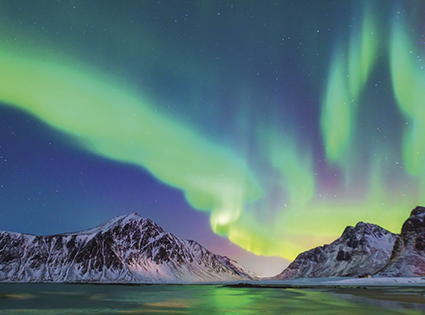The Science behind the Northern Lights
During the morning of February 27th, social media was flooded with beautiful photos of the northern lights. While it is not uncommon for Alaskans to post photos of their encounters with this majestic and unique phenomenon, this time it was different. The multicolored stripes waved through the sky with an unusual intensity. So much so that the phenomenon was spotted not only in Alaska but well below the Arctic region in the south of Canada, Michigan, and even in France, and the United Kingdom. The northern lights have amazed humans for centuries. Although the beautiful lights are fascinating, the science behind them is even more captivating.
The phenomenon begins with the sun, which releases streams of charged electrons into the solar wind, the constant flow of charged particles from the sun to the rest of the solar system. Sometimes they can be relatively moderate, like solar flares, or intense, like a Coronal Mass Ejection, when even plasma and portions of the Sun’s magnetic fields are launched into the Solar system. Particles from solar activity travel through space and eventually reach the Earth’s magnetic field. Their interactions create a series of disturbances called magnetic storms. These storms can have a negative impact on telecommunication, navigation, and electrical systems. The largest of these occurred in 1859 and was known as the Carrington Event. It took down the U.S. telegraph network and caused auroras visible from Texas. This is one of the reasons why scientists are concerned with auroras and the interactions of the sun and the Earth’s magnetic sphere so that they can further protect our systems from any disturbance. However, it would be reductive to say that the collision of solar particles with the Earth’s magnetic field directly causes the northern lights. Instead, it is the acceleration into the atmosphere of electrons from the streams of solar activity that leads to the beautiful light show. Electrons fall into the atmosphere and interact with different elements such as hydrogen, nitrogen, and oxygen. They heat these elements and lead to a reaction that causes them to produce different lights. According to NASA, oxygen produces greenish-yellow or red lights and nitrogen produces blue lights. While the two ends of the process were clear, for decades, scientists have been trying to understand how electrons become accelerated in the Earth’s atmosphere to produce the northern lights. A recent study published in the Journal of Geophysical Research has provided a breakthrough in understanding the cause of the northern lights. According to the study, the acceleration of electrons is due to a phenomenon called the Alvén waves. These waves are created by the interaction of solar activity with the Earth’s magnetic field. According to Jim Schroeder from Wheaton College: “The solar wind shakes Earth’s magnetic field in a number of ways, through eruption of solar plasma, or when the passing solar wind stretches out the geomagnetic field. Stretched magnetic field lines eventually reconnect and snap back toward earth, like a rubber band, launching a spectrum of Alfvén waves on their way.” The Alvén waves cause electrons to surf along the magnetic field lines toward the Earth’s atmosphere, where they collide with gas particles, producing the beautiful glow of the northern lights. The northern lights allow us to get a better glimpse into the interactions of our planet with our neighboring solar system and, as we continue to learn more about them, we can appreciate their beauty and complexity even more. So, keep your eyes up, because you never know when you will see them! |
